Small Business Enterprise Analysis Report - Trunki Company
VerifiedAdded on 2023/04/10
|24
|7142
|181
Report
AI Summary
This report provides a comprehensive analysis of Trunki, a small business enterprise, examining its business structure, strengths, and weaknesses through a SWOT analysis. It compares Trunki's financial performance with other small businesses, particularly Netitude Limited, highlighting key differences in production, sales, technology, and human resources. The report offers recommendations for improving management and business performance, including problem-solving strategies and action plans. It assesses existing business objectives, suggests areas for change, and outlines a plan for implementing these changes, including managing the impact on business operations and personnel. The report also addresses the challenges posed by online games and social media, and the impact of protectionist policies on the business.
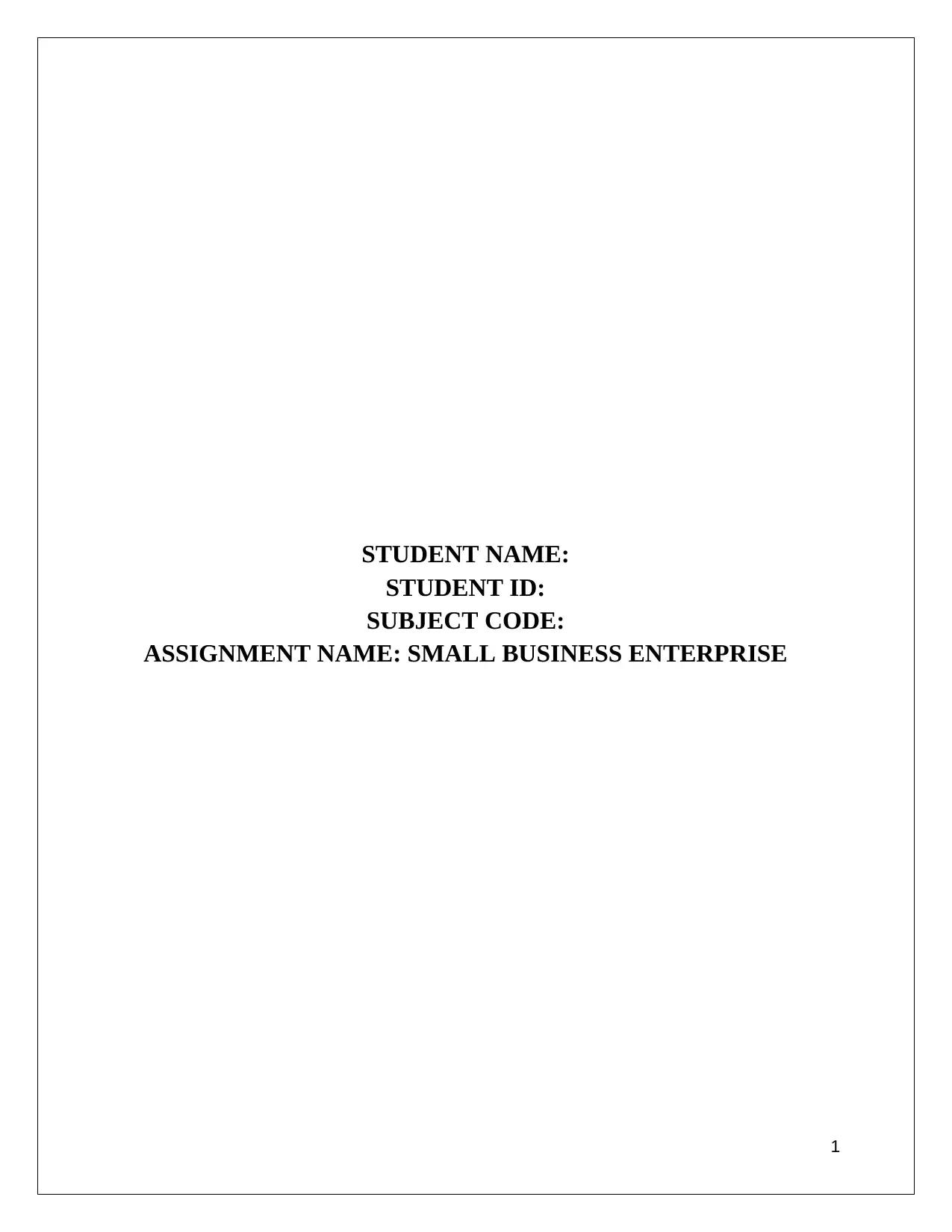
STUDENT NAME:
STUDENT ID:
SUBJECT CODE:
ASSIGNMENT NAME: SMALL BUSINESS ENTERPRISE
1
STUDENT ID:
SUBJECT CODE:
ASSIGNMENT NAME: SMALL BUSINESS ENTERPRISE
1
Paraphrase This Document
Need a fresh take? Get an instant paraphrase of this document with our AI Paraphraser
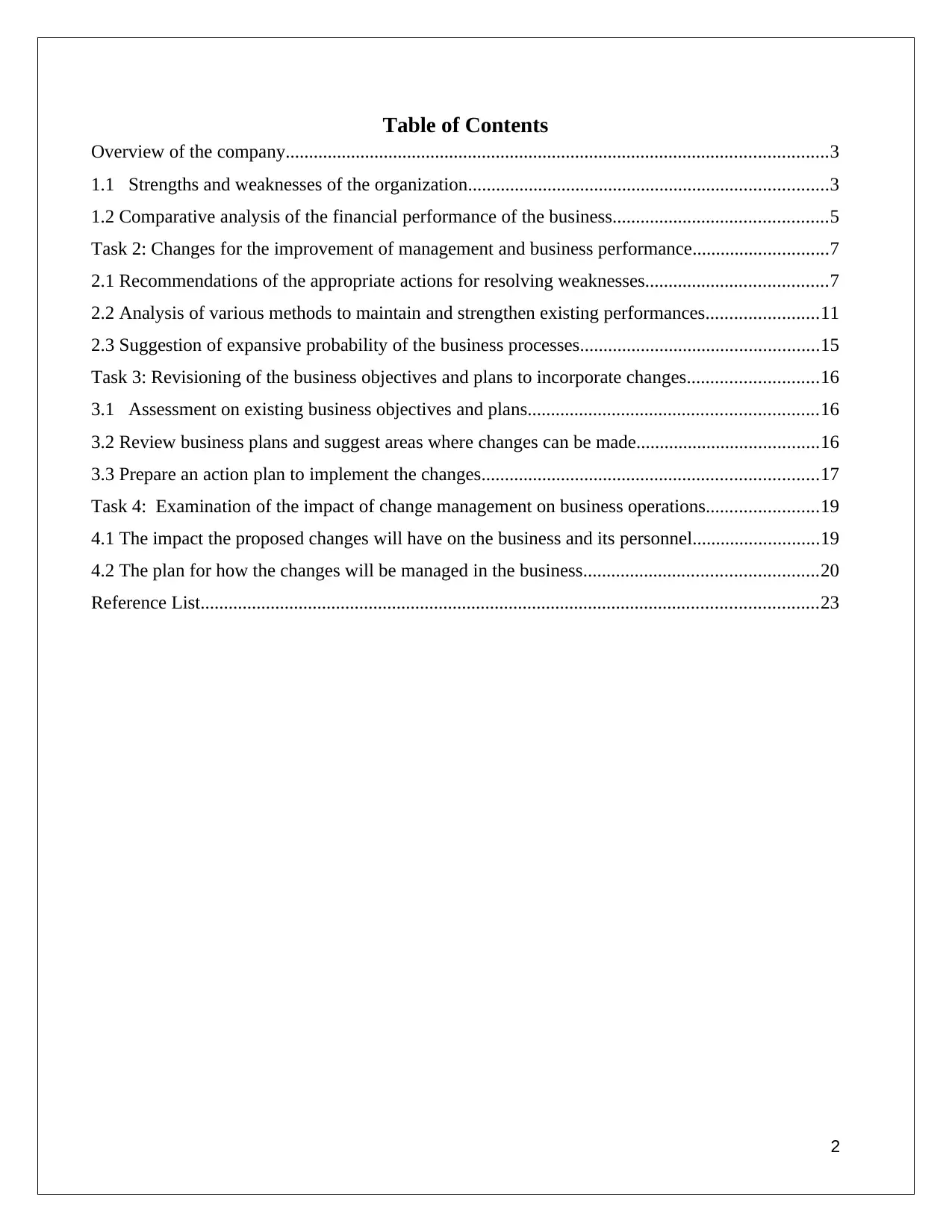
Table of Contents
Overview of the company....................................................................................................................3
1.1 Strengths and weaknesses of the organization.............................................................................3
1.2 Comparative analysis of the financial performance of the business..............................................5
Task 2: Changes for the improvement of management and business performance.............................7
2.1 Recommendations of the appropriate actions for resolving weaknesses.......................................7
2.2 Analysis of various methods to maintain and strengthen existing performances........................11
2.3 Suggestion of expansive probability of the business processes...................................................15
Task 3: Revisioning of the business objectives and plans to incorporate changes............................16
3.1 Assessment on existing business objectives and plans..............................................................16
3.2 Review business plans and suggest areas where changes can be made.......................................16
3.3 Prepare an action plan to implement the changes........................................................................17
Task 4: Examination of the impact of change management on business operations........................19
4.1 The impact the proposed changes will have on the business and its personnel...........................19
4.2 The plan for how the changes will be managed in the business..................................................20
Reference List....................................................................................................................................23
2
Overview of the company....................................................................................................................3
1.1 Strengths and weaknesses of the organization.............................................................................3
1.2 Comparative analysis of the financial performance of the business..............................................5
Task 2: Changes for the improvement of management and business performance.............................7
2.1 Recommendations of the appropriate actions for resolving weaknesses.......................................7
2.2 Analysis of various methods to maintain and strengthen existing performances........................11
2.3 Suggestion of expansive probability of the business processes...................................................15
Task 3: Revisioning of the business objectives and plans to incorporate changes............................16
3.1 Assessment on existing business objectives and plans..............................................................16
3.2 Review business plans and suggest areas where changes can be made.......................................16
3.3 Prepare an action plan to implement the changes........................................................................17
Task 4: Examination of the impact of change management on business operations........................19
4.1 The impact the proposed changes will have on the business and its personnel...........................19
4.2 The plan for how the changes will be managed in the business..................................................20
Reference List....................................................................................................................................23
2
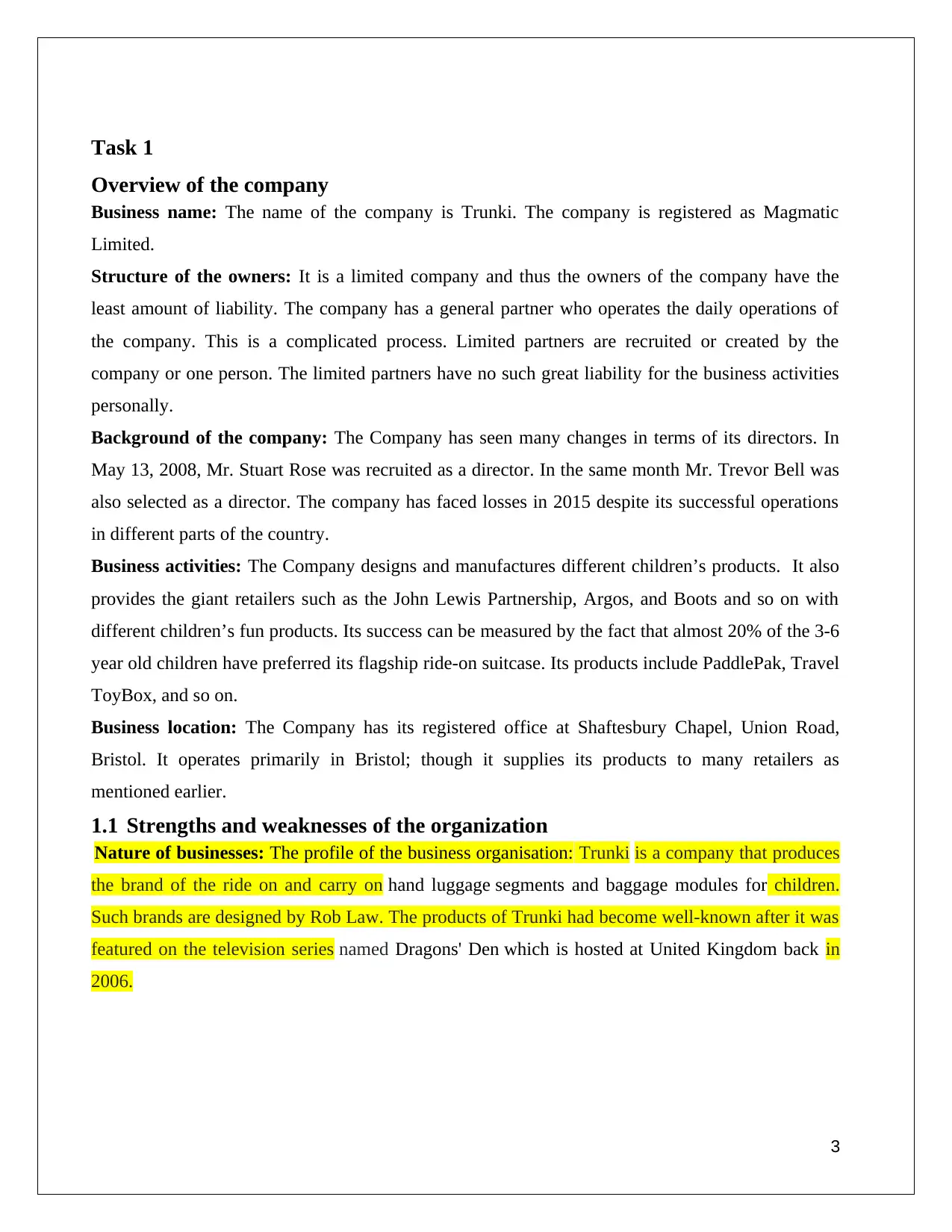
Task 1
Overview of the company
Business name: The name of the company is Trunki. The company is registered as Magmatic
Limited.
Structure of the owners: It is a limited company and thus the owners of the company have the
least amount of liability. The company has a general partner who operates the daily operations of
the company. This is a complicated process. Limited partners are recruited or created by the
company or one person. The limited partners have no such great liability for the business activities
personally.
Background of the company: The Company has seen many changes in terms of its directors. In
May 13, 2008, Mr. Stuart Rose was recruited as a director. In the same month Mr. Trevor Bell was
also selected as a director. The company has faced losses in 2015 despite its successful operations
in different parts of the country.
Business activities: The Company designs and manufactures different children’s products. It also
provides the giant retailers such as the John Lewis Partnership, Argos, and Boots and so on with
different children’s fun products. Its success can be measured by the fact that almost 20% of the 3-6
year old children have preferred its flagship ride-on suitcase. Its products include PaddlePak, Travel
ToyBox, and so on.
Business location: The Company has its registered office at Shaftesbury Chapel, Union Road,
Bristol. It operates primarily in Bristol; though it supplies its products to many retailers as
mentioned earlier.
1.1 Strengths and weaknesses of the organization
Nature of businesses: The profile of the business organisation: Trunki is a company that produces
the brand of the ride on and carry on hand luggage segments and baggage modules for children.
Such brands are designed by Rob Law. The products of Trunki had become well-known after it was
featured on the television series named Dragons' Den which is hosted at United Kingdom back in
2006.
3
Overview of the company
Business name: The name of the company is Trunki. The company is registered as Magmatic
Limited.
Structure of the owners: It is a limited company and thus the owners of the company have the
least amount of liability. The company has a general partner who operates the daily operations of
the company. This is a complicated process. Limited partners are recruited or created by the
company or one person. The limited partners have no such great liability for the business activities
personally.
Background of the company: The Company has seen many changes in terms of its directors. In
May 13, 2008, Mr. Stuart Rose was recruited as a director. In the same month Mr. Trevor Bell was
also selected as a director. The company has faced losses in 2015 despite its successful operations
in different parts of the country.
Business activities: The Company designs and manufactures different children’s products. It also
provides the giant retailers such as the John Lewis Partnership, Argos, and Boots and so on with
different children’s fun products. Its success can be measured by the fact that almost 20% of the 3-6
year old children have preferred its flagship ride-on suitcase. Its products include PaddlePak, Travel
ToyBox, and so on.
Business location: The Company has its registered office at Shaftesbury Chapel, Union Road,
Bristol. It operates primarily in Bristol; though it supplies its products to many retailers as
mentioned earlier.
1.1 Strengths and weaknesses of the organization
Nature of businesses: The profile of the business organisation: Trunki is a company that produces
the brand of the ride on and carry on hand luggage segments and baggage modules for children.
Such brands are designed by Rob Law. The products of Trunki had become well-known after it was
featured on the television series named Dragons' Den which is hosted at United Kingdom back in
2006.
3
⊘ This is a preview!⊘
Do you want full access?
Subscribe today to unlock all pages.

Trusted by 1+ million students worldwide
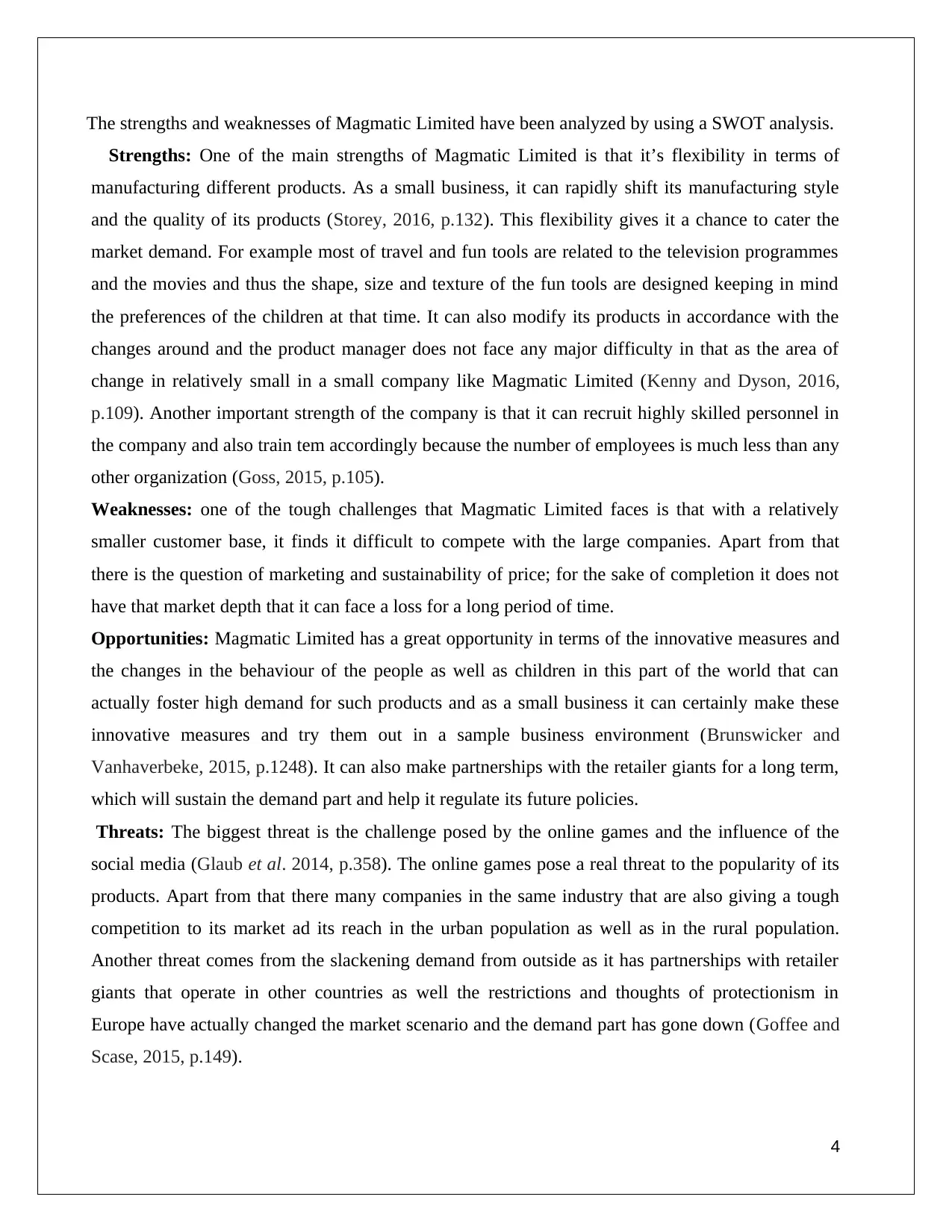
The strengths and weaknesses of Magmatic Limited have been analyzed by using a SWOT analysis.
Strengths: One of the main strengths of Magmatic Limited is that it’s flexibility in terms of
manufacturing different products. As a small business, it can rapidly shift its manufacturing style
and the quality of its products (Storey, 2016, p.132). This flexibility gives it a chance to cater the
market demand. For example most of travel and fun tools are related to the television programmes
and the movies and thus the shape, size and texture of the fun tools are designed keeping in mind
the preferences of the children at that time. It can also modify its products in accordance with the
changes around and the product manager does not face any major difficulty in that as the area of
change in relatively small in a small company like Magmatic Limited (Kenny and Dyson, 2016,
p.109). Another important strength of the company is that it can recruit highly skilled personnel in
the company and also train tem accordingly because the number of employees is much less than any
other organization (Goss, 2015, p.105).
Weaknesses: one of the tough challenges that Magmatic Limited faces is that with a relatively
smaller customer base, it finds it difficult to compete with the large companies. Apart from that
there is the question of marketing and sustainability of price; for the sake of completion it does not
have that market depth that it can face a loss for a long period of time.
Opportunities: Magmatic Limited has a great opportunity in terms of the innovative measures and
the changes in the behaviour of the people as well as children in this part of the world that can
actually foster high demand for such products and as a small business it can certainly make these
innovative measures and try them out in a sample business environment (Brunswicker and
Vanhaverbeke, 2015, p.1248). It can also make partnerships with the retailer giants for a long term,
which will sustain the demand part and help it regulate its future policies.
Threats: The biggest threat is the challenge posed by the online games and the influence of the
social media (Glaub et al. 2014, p.358). The online games pose a real threat to the popularity of its
products. Apart from that there many companies in the same industry that are also giving a tough
competition to its market ad its reach in the urban population as well as in the rural population.
Another threat comes from the slackening demand from outside as it has partnerships with retailer
giants that operate in other countries as well the restrictions and thoughts of protectionism in
Europe have actually changed the market scenario and the demand part has gone down (Goffee and
Scase, 2015, p.149).
4
Strengths: One of the main strengths of Magmatic Limited is that it’s flexibility in terms of
manufacturing different products. As a small business, it can rapidly shift its manufacturing style
and the quality of its products (Storey, 2016, p.132). This flexibility gives it a chance to cater the
market demand. For example most of travel and fun tools are related to the television programmes
and the movies and thus the shape, size and texture of the fun tools are designed keeping in mind
the preferences of the children at that time. It can also modify its products in accordance with the
changes around and the product manager does not face any major difficulty in that as the area of
change in relatively small in a small company like Magmatic Limited (Kenny and Dyson, 2016,
p.109). Another important strength of the company is that it can recruit highly skilled personnel in
the company and also train tem accordingly because the number of employees is much less than any
other organization (Goss, 2015, p.105).
Weaknesses: one of the tough challenges that Magmatic Limited faces is that with a relatively
smaller customer base, it finds it difficult to compete with the large companies. Apart from that
there is the question of marketing and sustainability of price; for the sake of completion it does not
have that market depth that it can face a loss for a long period of time.
Opportunities: Magmatic Limited has a great opportunity in terms of the innovative measures and
the changes in the behaviour of the people as well as children in this part of the world that can
actually foster high demand for such products and as a small business it can certainly make these
innovative measures and try them out in a sample business environment (Brunswicker and
Vanhaverbeke, 2015, p.1248). It can also make partnerships with the retailer giants for a long term,
which will sustain the demand part and help it regulate its future policies.
Threats: The biggest threat is the challenge posed by the online games and the influence of the
social media (Glaub et al. 2014, p.358). The online games pose a real threat to the popularity of its
products. Apart from that there many companies in the same industry that are also giving a tough
competition to its market ad its reach in the urban population as well as in the rural population.
Another threat comes from the slackening demand from outside as it has partnerships with retailer
giants that operate in other countries as well the restrictions and thoughts of protectionism in
Europe have actually changed the market scenario and the demand part has gone down (Goffee and
Scase, 2015, p.149).
4
Paraphrase This Document
Need a fresh take? Get an instant paraphrase of this document with our AI Paraphraser
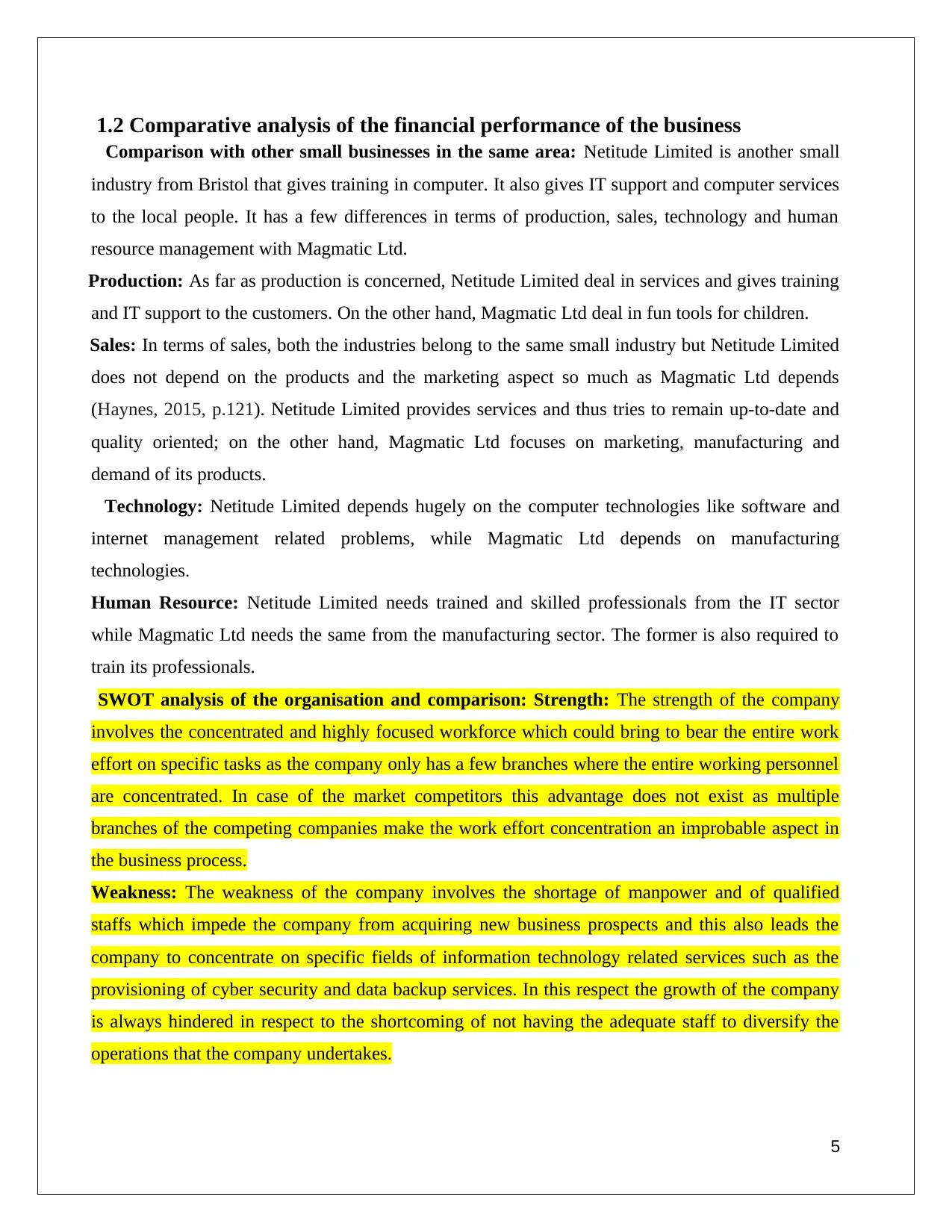
1.2 Comparative analysis of the financial performance of the business
Comparison with other small businesses in the same area: Netitude Limited is another small
industry from Bristol that gives training in computer. It also gives IT support and computer services
to the local people. It has a few differences in terms of production, sales, technology and human
resource management with Magmatic Ltd.
Production: As far as production is concerned, Netitude Limited deal in services and gives training
and IT support to the customers. On the other hand, Magmatic Ltd deal in fun tools for children.
Sales: In terms of sales, both the industries belong to the same small industry but Netitude Limited
does not depend on the products and the marketing aspect so much as Magmatic Ltd depends
(Haynes, 2015, p.121). Netitude Limited provides services and thus tries to remain up-to-date and
quality oriented; on the other hand, Magmatic Ltd focuses on marketing, manufacturing and
demand of its products.
Technology: Netitude Limited depends hugely on the computer technologies like software and
internet management related problems, while Magmatic Ltd depends on manufacturing
technologies.
Human Resource: Netitude Limited needs trained and skilled professionals from the IT sector
while Magmatic Ltd needs the same from the manufacturing sector. The former is also required to
train its professionals.
SWOT analysis of the organisation and comparison: Strength: The strength of the company
involves the concentrated and highly focused workforce which could bring to bear the entire work
effort on specific tasks as the company only has a few branches where the entire working personnel
are concentrated. In case of the market competitors this advantage does not exist as multiple
branches of the competing companies make the work effort concentration an improbable aspect in
the business process.
Weakness: The weakness of the company involves the shortage of manpower and of qualified
staffs which impede the company from acquiring new business prospects and this also leads the
company to concentrate on specific fields of information technology related services such as the
provisioning of cyber security and data backup services. In this respect the growth of the company
is always hindered in respect to the shortcoming of not having the adequate staff to diversify the
operations that the company undertakes.
5
Comparison with other small businesses in the same area: Netitude Limited is another small
industry from Bristol that gives training in computer. It also gives IT support and computer services
to the local people. It has a few differences in terms of production, sales, technology and human
resource management with Magmatic Ltd.
Production: As far as production is concerned, Netitude Limited deal in services and gives training
and IT support to the customers. On the other hand, Magmatic Ltd deal in fun tools for children.
Sales: In terms of sales, both the industries belong to the same small industry but Netitude Limited
does not depend on the products and the marketing aspect so much as Magmatic Ltd depends
(Haynes, 2015, p.121). Netitude Limited provides services and thus tries to remain up-to-date and
quality oriented; on the other hand, Magmatic Ltd focuses on marketing, manufacturing and
demand of its products.
Technology: Netitude Limited depends hugely on the computer technologies like software and
internet management related problems, while Magmatic Ltd depends on manufacturing
technologies.
Human Resource: Netitude Limited needs trained and skilled professionals from the IT sector
while Magmatic Ltd needs the same from the manufacturing sector. The former is also required to
train its professionals.
SWOT analysis of the organisation and comparison: Strength: The strength of the company
involves the concentrated and highly focused workforce which could bring to bear the entire work
effort on specific tasks as the company only has a few branches where the entire working personnel
are concentrated. In case of the market competitors this advantage does not exist as multiple
branches of the competing companies make the work effort concentration an improbable aspect in
the business process.
Weakness: The weakness of the company involves the shortage of manpower and of qualified
staffs which impede the company from acquiring new business prospects and this also leads the
company to concentrate on specific fields of information technology related services such as the
provisioning of cyber security and data backup services. In this respect the growth of the company
is always hindered in respect to the shortcoming of not having the adequate staff to diversify the
operations that the company undertakes.
5
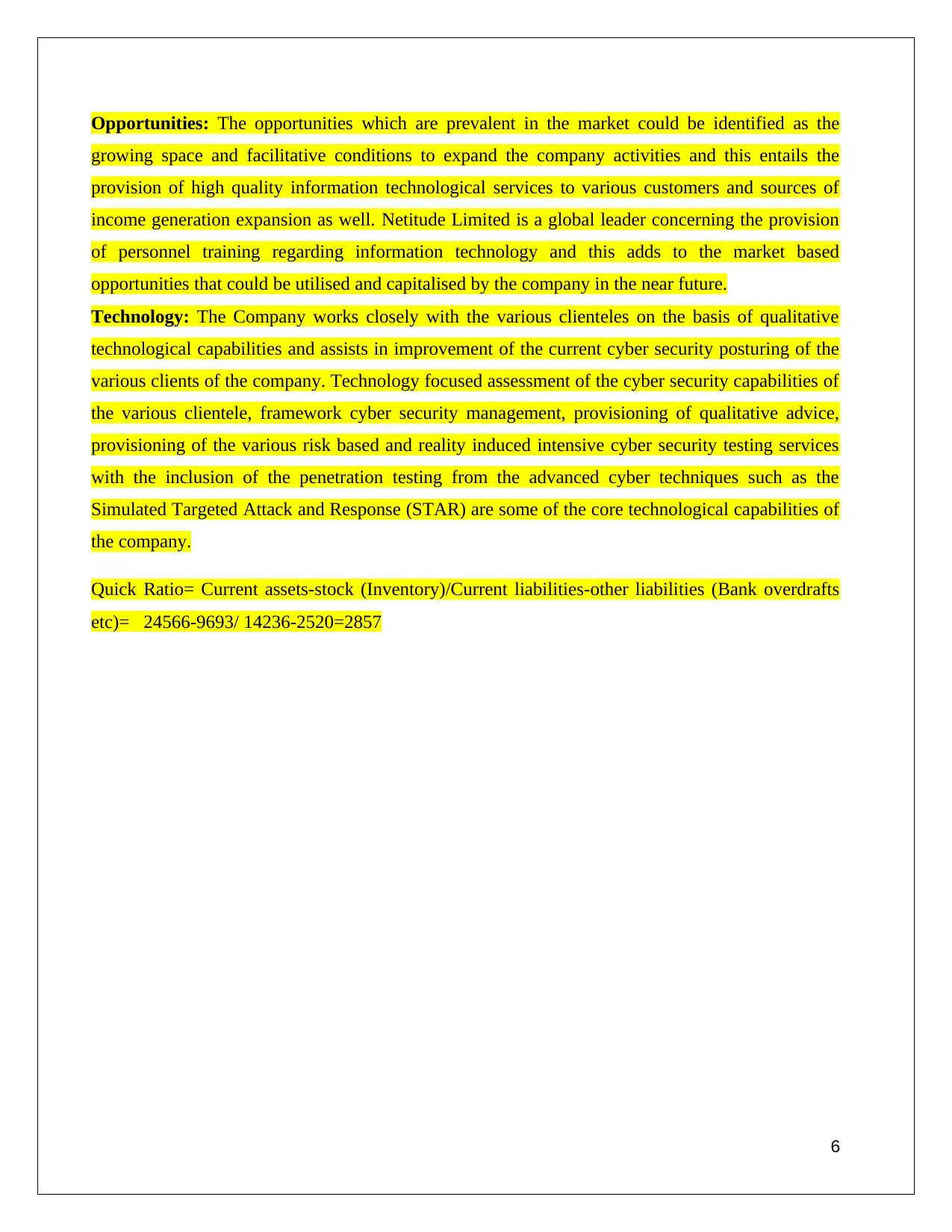
Opportunities: The opportunities which are prevalent in the market could be identified as the
growing space and facilitative conditions to expand the company activities and this entails the
provision of high quality information technological services to various customers and sources of
income generation expansion as well. Netitude Limited is a global leader concerning the provision
of personnel training regarding information technology and this adds to the market based
opportunities that could be utilised and capitalised by the company in the near future.
Technology: The Company works closely with the various clienteles on the basis of qualitative
technological capabilities and assists in improvement of the current cyber security posturing of the
various clients of the company. Technology focused assessment of the cyber security capabilities of
the various clientele, framework cyber security management, provisioning of qualitative advice,
provisioning of the various risk based and reality induced intensive cyber security testing services
with the inclusion of the penetration testing from the advanced cyber techniques such as the
Simulated Targeted Attack and Response (STAR) are some of the core technological capabilities of
the company.
Quick Ratio= Current assets-stock (Inventory)/Current liabilities-other liabilities (Bank overdrafts
etc)= 24566-9693/ 14236-2520=2857
6
growing space and facilitative conditions to expand the company activities and this entails the
provision of high quality information technological services to various customers and sources of
income generation expansion as well. Netitude Limited is a global leader concerning the provision
of personnel training regarding information technology and this adds to the market based
opportunities that could be utilised and capitalised by the company in the near future.
Technology: The Company works closely with the various clienteles on the basis of qualitative
technological capabilities and assists in improvement of the current cyber security posturing of the
various clients of the company. Technology focused assessment of the cyber security capabilities of
the various clientele, framework cyber security management, provisioning of qualitative advice,
provisioning of the various risk based and reality induced intensive cyber security testing services
with the inclusion of the penetration testing from the advanced cyber techniques such as the
Simulated Targeted Attack and Response (STAR) are some of the core technological capabilities of
the company.
Quick Ratio= Current assets-stock (Inventory)/Current liabilities-other liabilities (Bank overdrafts
etc)= 24566-9693/ 14236-2520=2857
6
⊘ This is a preview!⊘
Do you want full access?
Subscribe today to unlock all pages.

Trusted by 1+ million students worldwide
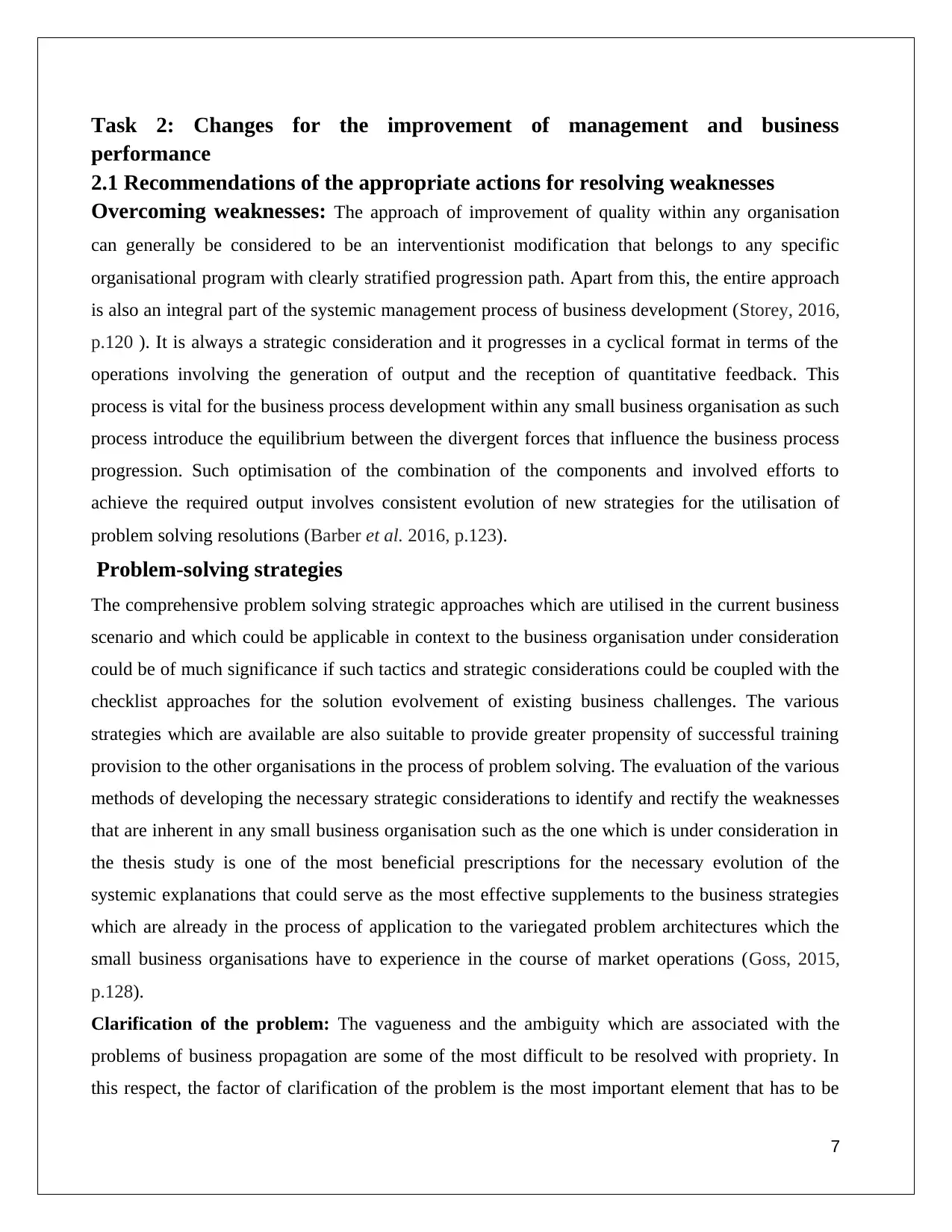
Task 2: Changes for the improvement of management and business
performance
2.1 Recommendations of the appropriate actions for resolving weaknesses
Overcoming weaknesses: The approach of improvement of quality within any organisation
can generally be considered to be an interventionist modification that belongs to any specific
organisational program with clearly stratified progression path. Apart from this, the entire approach
is also an integral part of the systemic management process of business development (Storey, 2016,
p.120 ). It is always a strategic consideration and it progresses in a cyclical format in terms of the
operations involving the generation of output and the reception of quantitative feedback. This
process is vital for the business process development within any small business organisation as such
process introduce the equilibrium between the divergent forces that influence the business process
progression. Such optimisation of the combination of the components and involved efforts to
achieve the required output involves consistent evolution of new strategies for the utilisation of
problem solving resolutions (Barber et al. 2016, p.123).
Problem-solving strategies
The comprehensive problem solving strategic approaches which are utilised in the current business
scenario and which could be applicable in context to the business organisation under consideration
could be of much significance if such tactics and strategic considerations could be coupled with the
checklist approaches for the solution evolvement of existing business challenges. The various
strategies which are available are also suitable to provide greater propensity of successful training
provision to the other organisations in the process of problem solving. The evaluation of the various
methods of developing the necessary strategic considerations to identify and rectify the weaknesses
that are inherent in any small business organisation such as the one which is under consideration in
the thesis study is one of the most beneficial prescriptions for the necessary evolution of the
systemic explanations that could serve as the most effective supplements to the business strategies
which are already in the process of application to the variegated problem architectures which the
small business organisations have to experience in the course of market operations (Goss, 2015,
p.128).
Clarification of the problem: The vagueness and the ambiguity which are associated with the
problems of business propagation are some of the most difficult to be resolved with propriety. In
this respect, the factor of clarification of the problem is the most important element that has to be
7
performance
2.1 Recommendations of the appropriate actions for resolving weaknesses
Overcoming weaknesses: The approach of improvement of quality within any organisation
can generally be considered to be an interventionist modification that belongs to any specific
organisational program with clearly stratified progression path. Apart from this, the entire approach
is also an integral part of the systemic management process of business development (Storey, 2016,
p.120 ). It is always a strategic consideration and it progresses in a cyclical format in terms of the
operations involving the generation of output and the reception of quantitative feedback. This
process is vital for the business process development within any small business organisation as such
process introduce the equilibrium between the divergent forces that influence the business process
progression. Such optimisation of the combination of the components and involved efforts to
achieve the required output involves consistent evolution of new strategies for the utilisation of
problem solving resolutions (Barber et al. 2016, p.123).
Problem-solving strategies
The comprehensive problem solving strategic approaches which are utilised in the current business
scenario and which could be applicable in context to the business organisation under consideration
could be of much significance if such tactics and strategic considerations could be coupled with the
checklist approaches for the solution evolvement of existing business challenges. The various
strategies which are available are also suitable to provide greater propensity of successful training
provision to the other organisations in the process of problem solving. The evaluation of the various
methods of developing the necessary strategic considerations to identify and rectify the weaknesses
that are inherent in any small business organisation such as the one which is under consideration in
the thesis study is one of the most beneficial prescriptions for the necessary evolution of the
systemic explanations that could serve as the most effective supplements to the business strategies
which are already in the process of application to the variegated problem architectures which the
small business organisations have to experience in the course of market operations (Goss, 2015,
p.128).
Clarification of the problem: The vagueness and the ambiguity which are associated with the
problems of business propagation are some of the most difficult to be resolved with propriety. In
this respect, the factor of clarification of the problem is the most important element that has to be
7
Paraphrase This Document
Need a fresh take? Get an instant paraphrase of this document with our AI Paraphraser
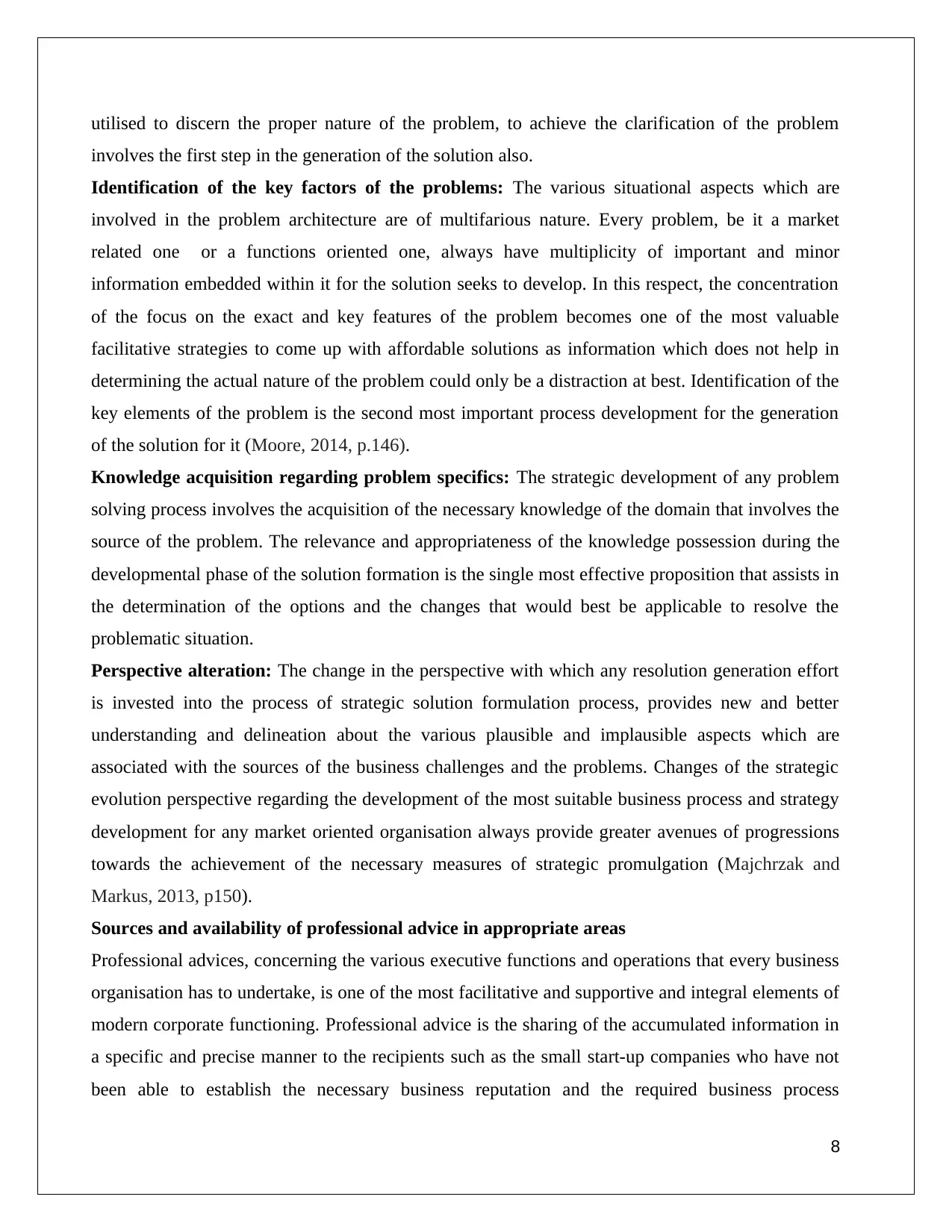
utilised to discern the proper nature of the problem, to achieve the clarification of the problem
involves the first step in the generation of the solution also.
Identification of the key factors of the problems: The various situational aspects which are
involved in the problem architecture are of multifarious nature. Every problem, be it a market
related one or a functions oriented one, always have multiplicity of important and minor
information embedded within it for the solution seeks to develop. In this respect, the concentration
of the focus on the exact and key features of the problem becomes one of the most valuable
facilitative strategies to come up with affordable solutions as information which does not help in
determining the actual nature of the problem could only be a distraction at best. Identification of the
key elements of the problem is the second most important process development for the generation
of the solution for it (Moore, 2014, p.146).
Knowledge acquisition regarding problem specifics: The strategic development of any problem
solving process involves the acquisition of the necessary knowledge of the domain that involves the
source of the problem. The relevance and appropriateness of the knowledge possession during the
developmental phase of the solution formation is the single most effective proposition that assists in
the determination of the options and the changes that would best be applicable to resolve the
problematic situation.
Perspective alteration: The change in the perspective with which any resolution generation effort
is invested into the process of strategic solution formulation process, provides new and better
understanding and delineation about the various plausible and implausible aspects which are
associated with the sources of the business challenges and the problems. Changes of the strategic
evolution perspective regarding the development of the most suitable business process and strategy
development for any market oriented organisation always provide greater avenues of progressions
towards the achievement of the necessary measures of strategic promulgation (Majchrzak and
Markus, 2013, p150).
Sources and availability of professional advice in appropriate areas
Professional advices, concerning the various executive functions and operations that every business
organisation has to undertake, is one of the most facilitative and supportive and integral elements of
modern corporate functioning. Professional advice is the sharing of the accumulated information in
a specific and precise manner to the recipients such as the small start-up companies who have not
been able to establish the necessary business reputation and the required business process
8
involves the first step in the generation of the solution also.
Identification of the key factors of the problems: The various situational aspects which are
involved in the problem architecture are of multifarious nature. Every problem, be it a market
related one or a functions oriented one, always have multiplicity of important and minor
information embedded within it for the solution seeks to develop. In this respect, the concentration
of the focus on the exact and key features of the problem becomes one of the most valuable
facilitative strategies to come up with affordable solutions as information which does not help in
determining the actual nature of the problem could only be a distraction at best. Identification of the
key elements of the problem is the second most important process development for the generation
of the solution for it (Moore, 2014, p.146).
Knowledge acquisition regarding problem specifics: The strategic development of any problem
solving process involves the acquisition of the necessary knowledge of the domain that involves the
source of the problem. The relevance and appropriateness of the knowledge possession during the
developmental phase of the solution formation is the single most effective proposition that assists in
the determination of the options and the changes that would best be applicable to resolve the
problematic situation.
Perspective alteration: The change in the perspective with which any resolution generation effort
is invested into the process of strategic solution formulation process, provides new and better
understanding and delineation about the various plausible and implausible aspects which are
associated with the sources of the business challenges and the problems. Changes of the strategic
evolution perspective regarding the development of the most suitable business process and strategy
development for any market oriented organisation always provide greater avenues of progressions
towards the achievement of the necessary measures of strategic promulgation (Majchrzak and
Markus, 2013, p150).
Sources and availability of professional advice in appropriate areas
Professional advices, concerning the various executive functions and operations that every business
organisation has to undertake, is one of the most facilitative and supportive and integral elements of
modern corporate functioning. Professional advice is the sharing of the accumulated information in
a specific and precise manner to the recipients such as the small start-up companies who have not
been able to establish the necessary business reputation and the required business process
8
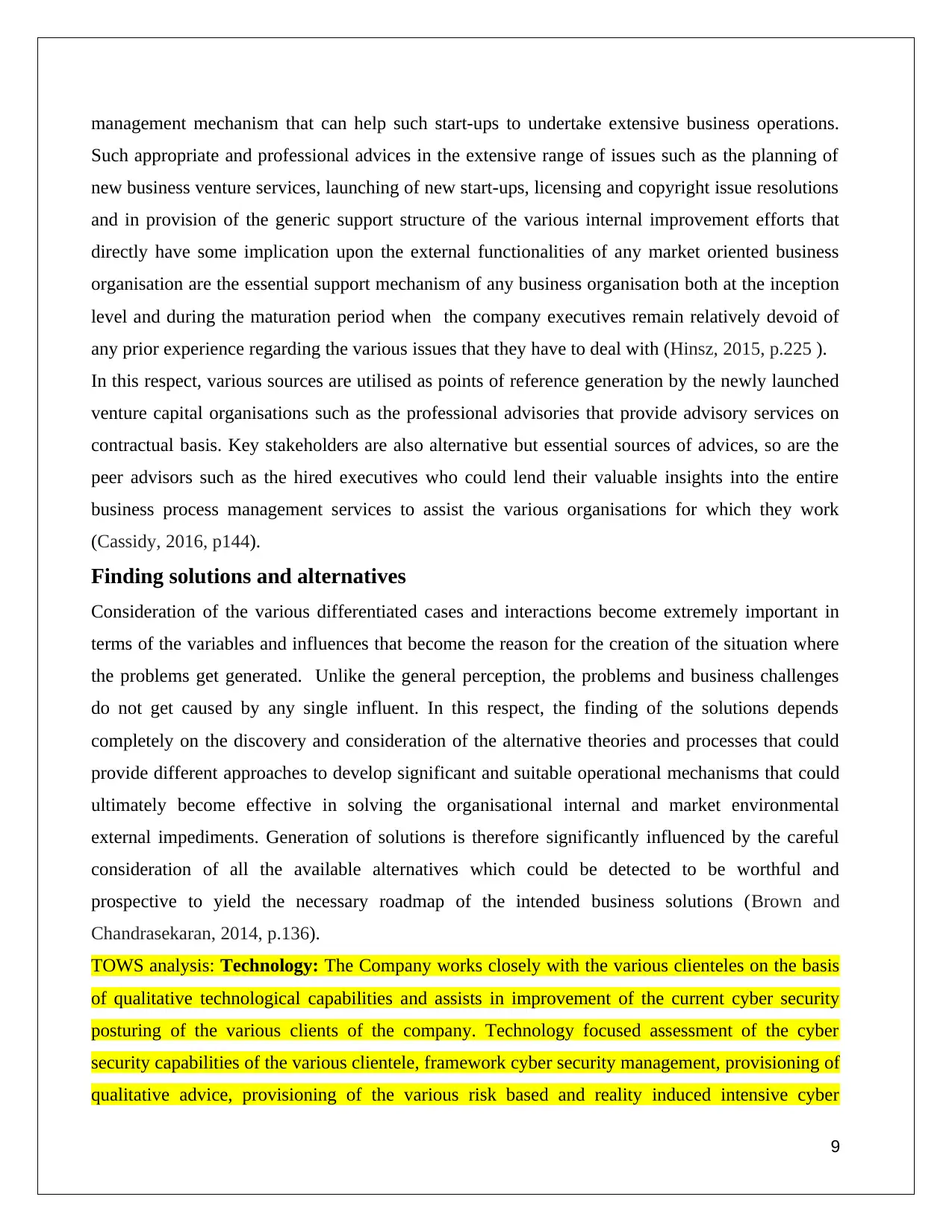
management mechanism that can help such start-ups to undertake extensive business operations.
Such appropriate and professional advices in the extensive range of issues such as the planning of
new business venture services, launching of new start-ups, licensing and copyright issue resolutions
and in provision of the generic support structure of the various internal improvement efforts that
directly have some implication upon the external functionalities of any market oriented business
organisation are the essential support mechanism of any business organisation both at the inception
level and during the maturation period when the company executives remain relatively devoid of
any prior experience regarding the various issues that they have to deal with (Hinsz, 2015, p.225 ).
In this respect, various sources are utilised as points of reference generation by the newly launched
venture capital organisations such as the professional advisories that provide advisory services on
contractual basis. Key stakeholders are also alternative but essential sources of advices, so are the
peer advisors such as the hired executives who could lend their valuable insights into the entire
business process management services to assist the various organisations for which they work
(Cassidy, 2016, p144).
Finding solutions and alternatives
Consideration of the various differentiated cases and interactions become extremely important in
terms of the variables and influences that become the reason for the creation of the situation where
the problems get generated. Unlike the general perception, the problems and business challenges
do not get caused by any single influent. In this respect, the finding of the solutions depends
completely on the discovery and consideration of the alternative theories and processes that could
provide different approaches to develop significant and suitable operational mechanisms that could
ultimately become effective in solving the organisational internal and market environmental
external impediments. Generation of solutions is therefore significantly influenced by the careful
consideration of all the available alternatives which could be detected to be worthful and
prospective to yield the necessary roadmap of the intended business solutions (Brown and
Chandrasekaran, 2014, p.136).
TOWS analysis: Technology: The Company works closely with the various clienteles on the basis
of qualitative technological capabilities and assists in improvement of the current cyber security
posturing of the various clients of the company. Technology focused assessment of the cyber
security capabilities of the various clientele, framework cyber security management, provisioning of
qualitative advice, provisioning of the various risk based and reality induced intensive cyber
9
Such appropriate and professional advices in the extensive range of issues such as the planning of
new business venture services, launching of new start-ups, licensing and copyright issue resolutions
and in provision of the generic support structure of the various internal improvement efforts that
directly have some implication upon the external functionalities of any market oriented business
organisation are the essential support mechanism of any business organisation both at the inception
level and during the maturation period when the company executives remain relatively devoid of
any prior experience regarding the various issues that they have to deal with (Hinsz, 2015, p.225 ).
In this respect, various sources are utilised as points of reference generation by the newly launched
venture capital organisations such as the professional advisories that provide advisory services on
contractual basis. Key stakeholders are also alternative but essential sources of advices, so are the
peer advisors such as the hired executives who could lend their valuable insights into the entire
business process management services to assist the various organisations for which they work
(Cassidy, 2016, p144).
Finding solutions and alternatives
Consideration of the various differentiated cases and interactions become extremely important in
terms of the variables and influences that become the reason for the creation of the situation where
the problems get generated. Unlike the general perception, the problems and business challenges
do not get caused by any single influent. In this respect, the finding of the solutions depends
completely on the discovery and consideration of the alternative theories and processes that could
provide different approaches to develop significant and suitable operational mechanisms that could
ultimately become effective in solving the organisational internal and market environmental
external impediments. Generation of solutions is therefore significantly influenced by the careful
consideration of all the available alternatives which could be detected to be worthful and
prospective to yield the necessary roadmap of the intended business solutions (Brown and
Chandrasekaran, 2014, p.136).
TOWS analysis: Technology: The Company works closely with the various clienteles on the basis
of qualitative technological capabilities and assists in improvement of the current cyber security
posturing of the various clients of the company. Technology focused assessment of the cyber
security capabilities of the various clientele, framework cyber security management, provisioning of
qualitative advice, provisioning of the various risk based and reality induced intensive cyber
9
⊘ This is a preview!⊘
Do you want full access?
Subscribe today to unlock all pages.

Trusted by 1+ million students worldwide
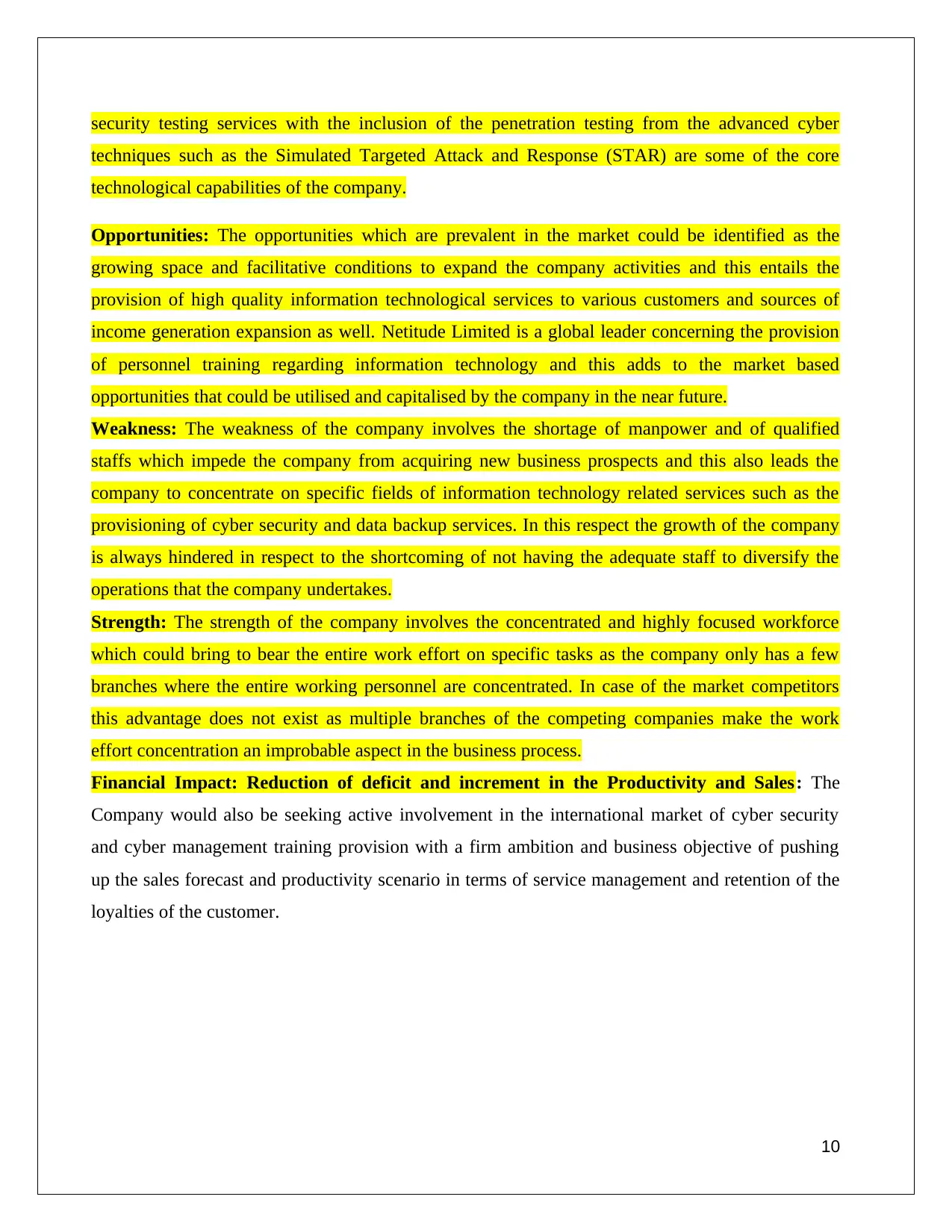
security testing services with the inclusion of the penetration testing from the advanced cyber
techniques such as the Simulated Targeted Attack and Response (STAR) are some of the core
technological capabilities of the company.
Opportunities: The opportunities which are prevalent in the market could be identified as the
growing space and facilitative conditions to expand the company activities and this entails the
provision of high quality information technological services to various customers and sources of
income generation expansion as well. Netitude Limited is a global leader concerning the provision
of personnel training regarding information technology and this adds to the market based
opportunities that could be utilised and capitalised by the company in the near future.
Weakness: The weakness of the company involves the shortage of manpower and of qualified
staffs which impede the company from acquiring new business prospects and this also leads the
company to concentrate on specific fields of information technology related services such as the
provisioning of cyber security and data backup services. In this respect the growth of the company
is always hindered in respect to the shortcoming of not having the adequate staff to diversify the
operations that the company undertakes.
Strength: The strength of the company involves the concentrated and highly focused workforce
which could bring to bear the entire work effort on specific tasks as the company only has a few
branches where the entire working personnel are concentrated. In case of the market competitors
this advantage does not exist as multiple branches of the competing companies make the work
effort concentration an improbable aspect in the business process.
Financial Impact: Reduction of deficit and increment in the Productivity and Sales: The
Company would also be seeking active involvement in the international market of cyber security
and cyber management training provision with a firm ambition and business objective of pushing
up the sales forecast and productivity scenario in terms of service management and retention of the
loyalties of the customer.
10
techniques such as the Simulated Targeted Attack and Response (STAR) are some of the core
technological capabilities of the company.
Opportunities: The opportunities which are prevalent in the market could be identified as the
growing space and facilitative conditions to expand the company activities and this entails the
provision of high quality information technological services to various customers and sources of
income generation expansion as well. Netitude Limited is a global leader concerning the provision
of personnel training regarding information technology and this adds to the market based
opportunities that could be utilised and capitalised by the company in the near future.
Weakness: The weakness of the company involves the shortage of manpower and of qualified
staffs which impede the company from acquiring new business prospects and this also leads the
company to concentrate on specific fields of information technology related services such as the
provisioning of cyber security and data backup services. In this respect the growth of the company
is always hindered in respect to the shortcoming of not having the adequate staff to diversify the
operations that the company undertakes.
Strength: The strength of the company involves the concentrated and highly focused workforce
which could bring to bear the entire work effort on specific tasks as the company only has a few
branches where the entire working personnel are concentrated. In case of the market competitors
this advantage does not exist as multiple branches of the competing companies make the work
effort concentration an improbable aspect in the business process.
Financial Impact: Reduction of deficit and increment in the Productivity and Sales: The
Company would also be seeking active involvement in the international market of cyber security
and cyber management training provision with a firm ambition and business objective of pushing
up the sales forecast and productivity scenario in terms of service management and retention of the
loyalties of the customer.
10
Paraphrase This Document
Need a fresh take? Get an instant paraphrase of this document with our AI Paraphraser
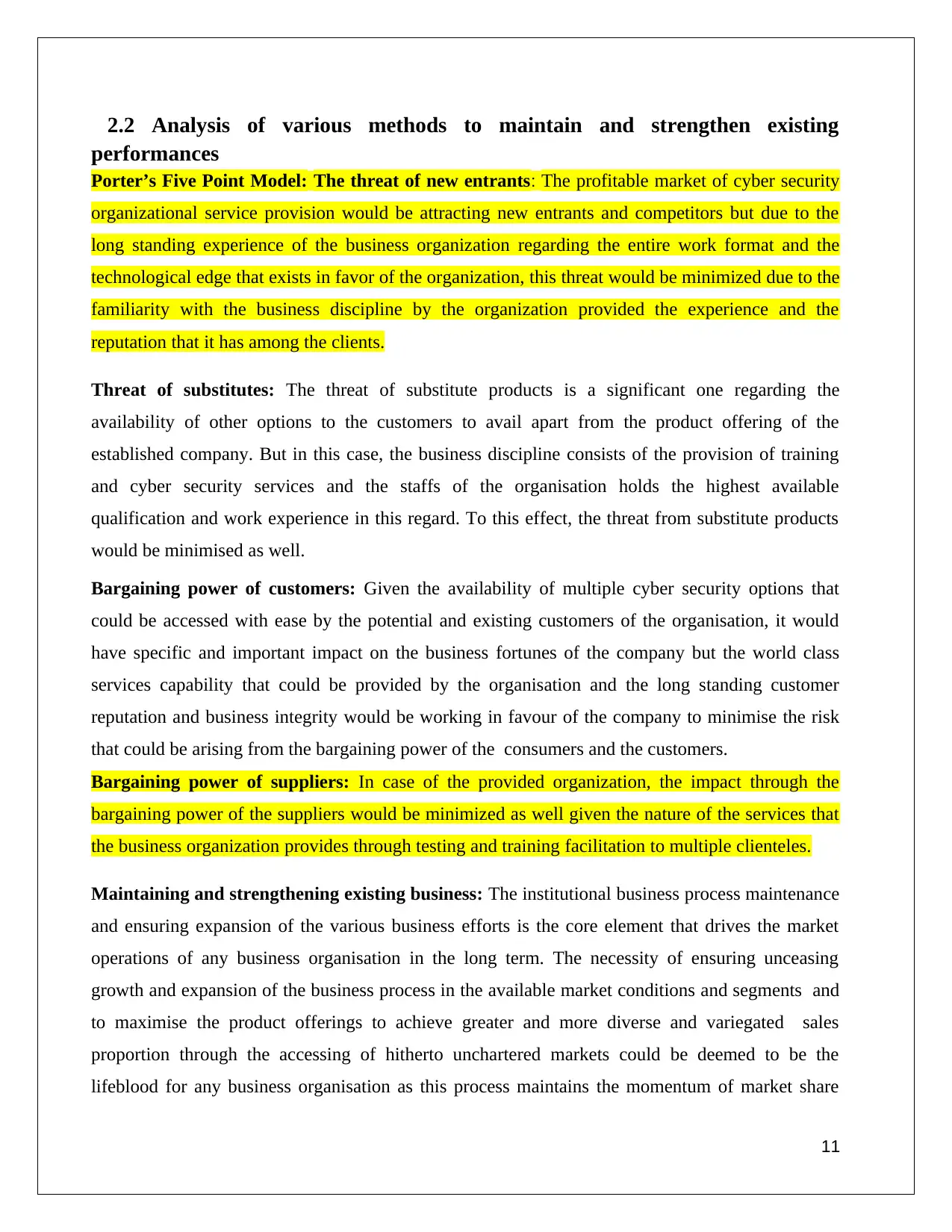
2.2 Analysis of various methods to maintain and strengthen existing
performances
Porter’s Five Point Model: The threat of new entrants: The profitable market of cyber security
organizational service provision would be attracting new entrants and competitors but due to the
long standing experience of the business organization regarding the entire work format and the
technological edge that exists in favor of the organization, this threat would be minimized due to the
familiarity with the business discipline by the organization provided the experience and the
reputation that it has among the clients.
Threat of substitutes: The threat of substitute products is a significant one regarding the
availability of other options to the customers to avail apart from the product offering of the
established company. But in this case, the business discipline consists of the provision of training
and cyber security services and the staffs of the organisation holds the highest available
qualification and work experience in this regard. To this effect, the threat from substitute products
would be minimised as well.
Bargaining power of customers: Given the availability of multiple cyber security options that
could be accessed with ease by the potential and existing customers of the organisation, it would
have specific and important impact on the business fortunes of the company but the world class
services capability that could be provided by the organisation and the long standing customer
reputation and business integrity would be working in favour of the company to minimise the risk
that could be arising from the bargaining power of the consumers and the customers.
Bargaining power of suppliers: In case of the provided organization, the impact through the
bargaining power of the suppliers would be minimized as well given the nature of the services that
the business organization provides through testing and training facilitation to multiple clienteles.
Maintaining and strengthening existing business: The institutional business process maintenance
and ensuring expansion of the various business efforts is the core element that drives the market
operations of any business organisation in the long term. The necessity of ensuring unceasing
growth and expansion of the business process in the available market conditions and segments and
to maximise the product offerings to achieve greater and more diverse and variegated sales
proportion through the accessing of hitherto unchartered markets could be deemed to be the
lifeblood for any business organisation as this process maintains the momentum of market share
11
performances
Porter’s Five Point Model: The threat of new entrants: The profitable market of cyber security
organizational service provision would be attracting new entrants and competitors but due to the
long standing experience of the business organization regarding the entire work format and the
technological edge that exists in favor of the organization, this threat would be minimized due to the
familiarity with the business discipline by the organization provided the experience and the
reputation that it has among the clients.
Threat of substitutes: The threat of substitute products is a significant one regarding the
availability of other options to the customers to avail apart from the product offering of the
established company. But in this case, the business discipline consists of the provision of training
and cyber security services and the staffs of the organisation holds the highest available
qualification and work experience in this regard. To this effect, the threat from substitute products
would be minimised as well.
Bargaining power of customers: Given the availability of multiple cyber security options that
could be accessed with ease by the potential and existing customers of the organisation, it would
have specific and important impact on the business fortunes of the company but the world class
services capability that could be provided by the organisation and the long standing customer
reputation and business integrity would be working in favour of the company to minimise the risk
that could be arising from the bargaining power of the consumers and the customers.
Bargaining power of suppliers: In case of the provided organization, the impact through the
bargaining power of the suppliers would be minimized as well given the nature of the services that
the business organization provides through testing and training facilitation to multiple clienteles.
Maintaining and strengthening existing business: The institutional business process maintenance
and ensuring expansion of the various business efforts is the core element that drives the market
operations of any business organisation in the long term. The necessity of ensuring unceasing
growth and expansion of the business process in the available market conditions and segments and
to maximise the product offerings to achieve greater and more diverse and variegated sales
proportion through the accessing of hitherto unchartered markets could be deemed to be the
lifeblood for any business organisation as this process maintains the momentum of market share
11
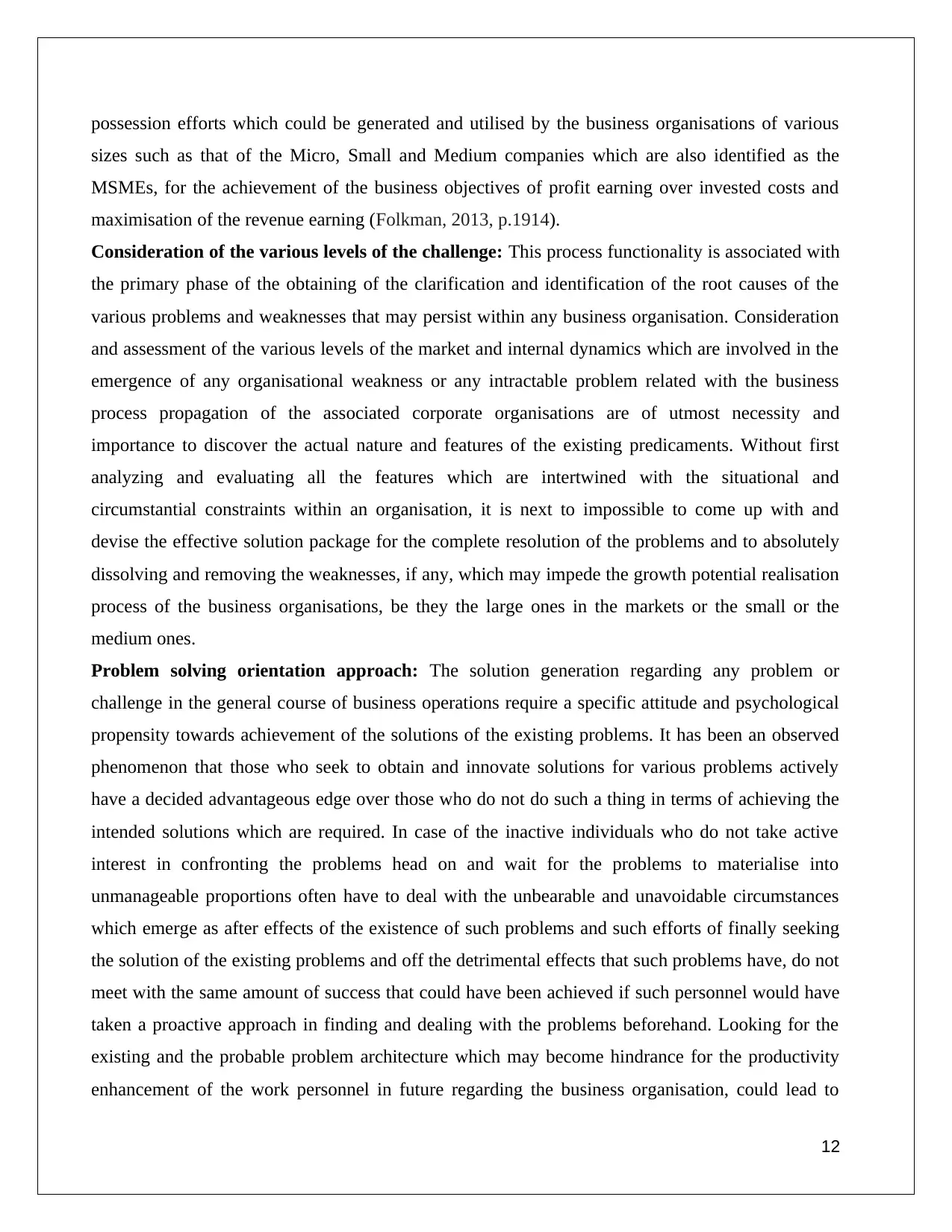
possession efforts which could be generated and utilised by the business organisations of various
sizes such as that of the Micro, Small and Medium companies which are also identified as the
MSMEs, for the achievement of the business objectives of profit earning over invested costs and
maximisation of the revenue earning (Folkman, 2013, p.1914).
Consideration of the various levels of the challenge: This process functionality is associated with
the primary phase of the obtaining of the clarification and identification of the root causes of the
various problems and weaknesses that may persist within any business organisation. Consideration
and assessment of the various levels of the market and internal dynamics which are involved in the
emergence of any organisational weakness or any intractable problem related with the business
process propagation of the associated corporate organisations are of utmost necessity and
importance to discover the actual nature and features of the existing predicaments. Without first
analyzing and evaluating all the features which are intertwined with the situational and
circumstantial constraints within an organisation, it is next to impossible to come up with and
devise the effective solution package for the complete resolution of the problems and to absolutely
dissolving and removing the weaknesses, if any, which may impede the growth potential realisation
process of the business organisations, be they the large ones in the markets or the small or the
medium ones.
Problem solving orientation approach: The solution generation regarding any problem or
challenge in the general course of business operations require a specific attitude and psychological
propensity towards achievement of the solutions of the existing problems. It has been an observed
phenomenon that those who seek to obtain and innovate solutions for various problems actively
have a decided advantageous edge over those who do not do such a thing in terms of achieving the
intended solutions which are required. In case of the inactive individuals who do not take active
interest in confronting the problems head on and wait for the problems to materialise into
unmanageable proportions often have to deal with the unbearable and unavoidable circumstances
which emerge as after effects of the existence of such problems and such efforts of finally seeking
the solution of the existing problems and off the detrimental effects that such problems have, do not
meet with the same amount of success that could have been achieved if such personnel would have
taken a proactive approach in finding and dealing with the problems beforehand. Looking for the
existing and the probable problem architecture which may become hindrance for the productivity
enhancement of the work personnel in future regarding the business organisation, could lead to
12
sizes such as that of the Micro, Small and Medium companies which are also identified as the
MSMEs, for the achievement of the business objectives of profit earning over invested costs and
maximisation of the revenue earning (Folkman, 2013, p.1914).
Consideration of the various levels of the challenge: This process functionality is associated with
the primary phase of the obtaining of the clarification and identification of the root causes of the
various problems and weaknesses that may persist within any business organisation. Consideration
and assessment of the various levels of the market and internal dynamics which are involved in the
emergence of any organisational weakness or any intractable problem related with the business
process propagation of the associated corporate organisations are of utmost necessity and
importance to discover the actual nature and features of the existing predicaments. Without first
analyzing and evaluating all the features which are intertwined with the situational and
circumstantial constraints within an organisation, it is next to impossible to come up with and
devise the effective solution package for the complete resolution of the problems and to absolutely
dissolving and removing the weaknesses, if any, which may impede the growth potential realisation
process of the business organisations, be they the large ones in the markets or the small or the
medium ones.
Problem solving orientation approach: The solution generation regarding any problem or
challenge in the general course of business operations require a specific attitude and psychological
propensity towards achievement of the solutions of the existing problems. It has been an observed
phenomenon that those who seek to obtain and innovate solutions for various problems actively
have a decided advantageous edge over those who do not do such a thing in terms of achieving the
intended solutions which are required. In case of the inactive individuals who do not take active
interest in confronting the problems head on and wait for the problems to materialise into
unmanageable proportions often have to deal with the unbearable and unavoidable circumstances
which emerge as after effects of the existence of such problems and such efforts of finally seeking
the solution of the existing problems and off the detrimental effects that such problems have, do not
meet with the same amount of success that could have been achieved if such personnel would have
taken a proactive approach in finding and dealing with the problems beforehand. Looking for the
existing and the probable problem architecture which may become hindrance for the productivity
enhancement of the work personnel in future regarding the business organisation, could lead to
12
⊘ This is a preview!⊘
Do you want full access?
Subscribe today to unlock all pages.

Trusted by 1+ million students worldwide
1 out of 24
Related Documents
Your All-in-One AI-Powered Toolkit for Academic Success.
+13062052269
info@desklib.com
Available 24*7 on WhatsApp / Email
![[object Object]](/_next/static/media/star-bottom.7253800d.svg)
Unlock your academic potential
Copyright © 2020–2025 A2Z Services. All Rights Reserved. Developed and managed by ZUCOL.




